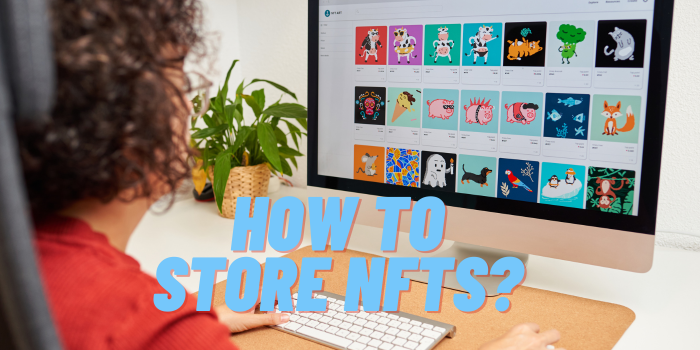Anyone interested in the crypto industry must know what NFTs are and how they have made people millionaires with minimal investment. Traders have turned $50 NFTs into $500,000 only because of making the right decisions at the perfect time. If you’re new to crypto, knowing about NFTs can significantly increase your chances of making a higher profit.
This article is for people interested in trading NFTs to profit significantly. If you’re unsure why you should invest in the crypto market, read here. So without any delay, let’s start today’s topic.
Also read: Bitcoin Crash: What Was Behind the Crypto Collapse?
How to Buy NFTs?

If you’re interested in buying NFTs for collecting or investment purposes, various platforms are available depending on your preferences. For art NFTs, you can explore Nifty Gateway, which offers a diverse collection of art NFTs. Another option is OpenSea, known as the first and largest NFT marketplace.
When purchasing NFTs, you’ll need to connect a payment card or a cryptocurrency wallet to the platform you’re using. For instance, if you’re buying and storing NFTs on the Ethereum (ETH) network, you’ll need to connect a cryptocurrency wallet like Coinbase that is compatible with the ETH network.
It’s worth noting that there is often high demand for different types of NFTs, leading to their release in limited-time “Drops”. Drops are events where a limited number of items become available quickly, similar to concert ticket sales or sneaker releases. This creates a rush among buyers to secure the NFT within the limited timeframe.
Also Read: Why Should You Invest in Cryptocurrency Right Now?
How to Store NFTs?

Storing NFTs is relatively straightforward, especially if you are familiar with using a cryptocurrency wallet. Many NFT wallets are essentially modified crypto wallets that support NFTs. While the processes of buying and storing NFTs are similar to those of buying and storing cryptocurrencies, there are some differences.
Once you have purchased an NFT, you need a secure place to store it. The most suitable option for storing NFTs is an NFT wallet. Let’s explore the three main methods to store your NFTs securely.
1. Software Wallets
Software wallets provide an easy online storage solution for non-technical users and beginners who want to store their NFTs. These wallets have user-friendly interfaces and are widely used by the general public. One of the most popular software wallets for NFT storage is MetaMask. It offers standard security measures to protect your non-fungible tokens.
Overall, software wallets provide a convenient and accessible option for storing NFTs, particularly for users who may not have extensive technical knowledge or experience. Choosing a reputable wallet and taking necessary security precautions to safeguard your NFTs is essential. You can check out our guide on the 7 best crypto wallets to learn more about them.
2. InterPlanetary File System (IPFS)
The InterPlanetary File System (IPFS) is a hypermedia protocol that operates on a peer-to-peer network, enabling users to store their non-fungible tokens (NFTs) off-chain. It revolutionises the distribution of information globally. Unlike traditional systems that use location-based addressing, IPFS utilises content-based addressing.
When a user uploads a file to IPFS, it is divided into smaller pieces, each of which is cryptographically hashed and assigned a unique fingerprint called a Content Identifier (CID). These CIDs directly link to the corresponding NFTs, providing a permanent record for the file. With IPFS, users can create new versions of their files while maintaining the integrity of the original. This means that files stored on IPFS are resistant to tampering and censorship.
3. Hardware Wallets
A cold, offline, or hardware wallet is one of the most popular and highly secure options for storing non-fungible tokens (NFTs). This type of wallet involves storing the private keys required to access ownership of NFTs on a physical device not connected to the internet.
By keeping the keys offline, the vulnerability of the wallet to online threats is significantly reduced. Additionally, hardware wallets often incorporate two-factor authentication as an extra layer of security. Hacking into a physical hardware wallet without gaining physical access is virtually impossible. For further knowledge, you can also read our article on the difference between cold and hot wallets.
How to Trade NFTs?

Understanding how cryptocurrency exchanges operate can be advantageous when trading NFTs or other crypto assets. Crypto exchanges serve as platforms for buying and selling crypto assets, including NFTs. However, not all exchanges have dedicated NFT marketplaces.
Therefore, seeking out exchanges and wallets that offer such marketplaces is essential. Let’s look at the steps you should take as a newbie NFT trader to ensure you buy them correctly.
Step 1: Sign Up on a Crypto Exchange or Wallet
Look for a crypto exchange with an NFT marketplace or a wallet that supports NFT trading. The exchange will serve as the platform to connect with other traders, while the wallet will store your assets. Some platforms even integrate the NFT marketplace API into their wallets for convenience.
When signing up on a centralised exchange, you may need to provide the necessary documents for KYC verification. However, decentralised exchanges often require only the creation of an account and the safeguarding of the recovery phrase. You can sign up on OpenSea as it’s one of the most reliable.
Step 2: Prepare to Acquire NFTs
Once you have signed up and set up your account, you can purchase NFTs. It’s important to note that NFTs can be bought using cryptocurrencies like Ether (ETH) or any other currency such as Solana (SOL). Before making a purchase, it is advisable to check which trading pairs the exchange supports.
Step 3: Trade NFTs in the Marketplace
With your account set up and sufficient funds available in cryptocurrency or other NFTs, you can navigate the marketplace and begin trading. You can explore the available listings or search for specific NFTs you wish to buy or sell. After purchasing an NFT, you can store it in your preferred wallet for safekeeping and sell them whenever you want on the marketplace for a profit.
Frequently Asked Questions
How Much Do NFT Wallets Cost?
There is no fee if you’re using a software or hot wallet, as these wallets are free for the general public. But if you decide to buy a hardware wallet to be more secure, it can cost anywhere from around $80 to $500 if you go for a higher-end one. Also, ensure that your hardware wallet is NFT-compatible, as most aren’t.
Is NFT Trading Safe?
If it’s a cryptocurrency, NFT, stocks, or Forex, there’s risk involved. Proper research is the only thing that differentiates you from those losing their investment. Make sure to verify the NFT project and only go for the ones that have a history of building and launching successful NFT collections.
Can NFTs Be Stolen or Copied?
Every NFT has a unique digital signature imprinted with your user ID, meaning you cannot be copied as digital photos. Also, much information, including the seed phrase, is required to steal an NFT. So if you keep your key safe, your NFTs are safe forever.





